2013 BMW 335I CONVERTIBLE tire pressure
[x] Cancel search: tire pressurePage 140 of 308
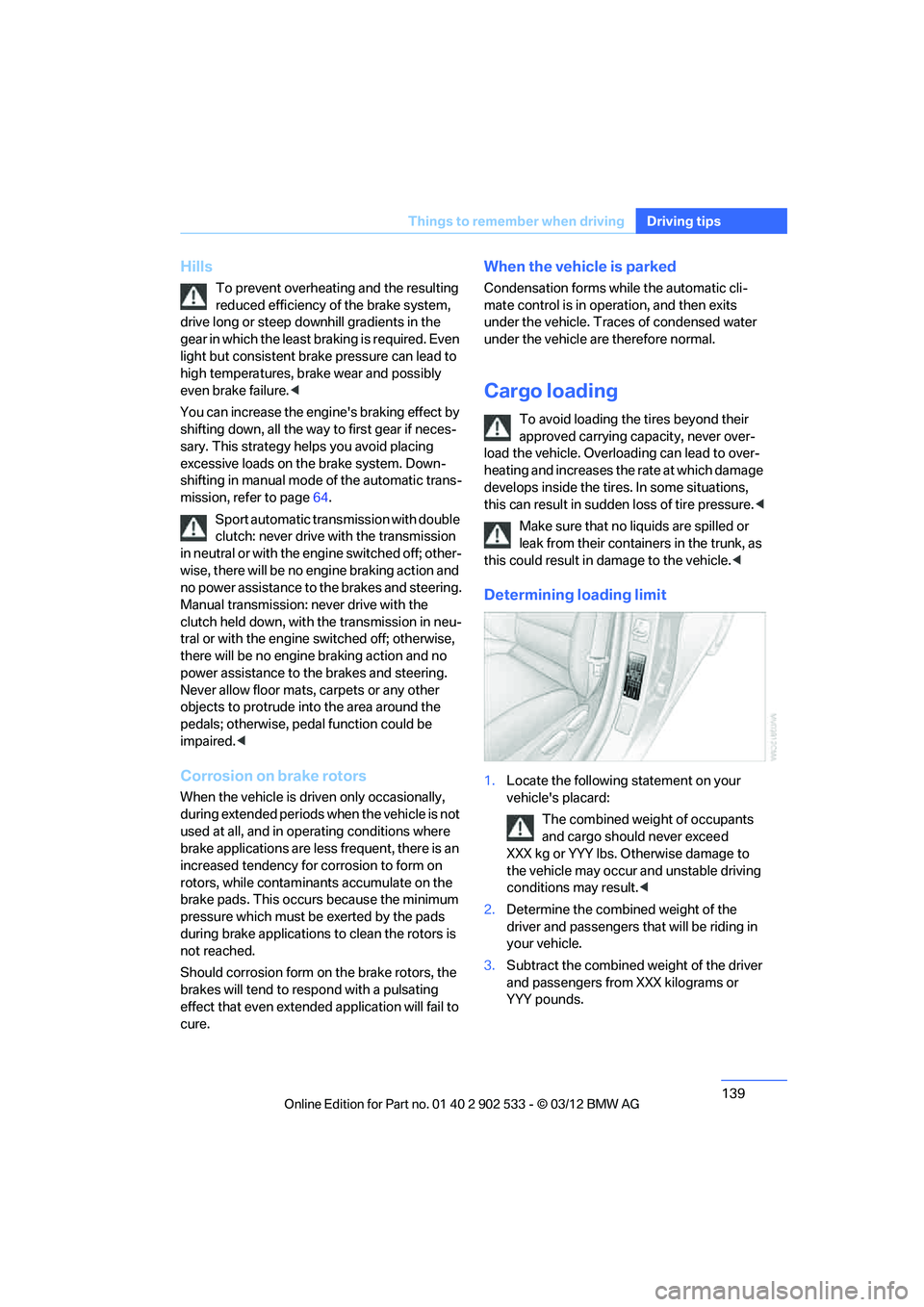
139
Things to remember when driving
Driving tips
Hills
To prevent overheating and the resulting
reduced efficiency of the brake system,
drive long or steep downhill gradients in the
gear in which the least braking is required. Even
light but consistent brake pressure can lead to
high temperatures, brake wear and possibly
even brake failure. <
You can increase the engine's braking effect by
shifting down, all the way to first gear if neces-
sary. This strategy helps you avoid placing
excessive loads on the brake system. Down-
shifting in manual mode of the automatic trans-
mission, refer to page 64.
Sport automatic transmission with double
clutch: never drive with the transmission
in neutral or with the engine switched off; other-
wise, there will be no engine braking action and
no power assistance to the brakes and steering.
Manual transmission: never drive with the
clutch held down, with the transmission in neu-
tral or with the engine switched off; otherwise,
there will be no engine braking action and no
power assistance to the brakes and steering.
Never allow floor mats, carpets or any other
objects to protrude into the area around the
pedals; otherwise, pedal function could be
impaired. <
Corrosion on brake rotors
When the vehicle is driven only occasionally,
during extended periods when the vehicle is not
used at all, and in operating conditions where
brake applications are less frequent, there is an
increased tendency for corrosion to form on
rotors, while contaminants accumulate on the
brake pads. This occurs because the minimum
pressure which must be exerted by the pads
during brake applications to clean the rotors is
not reached.
Should corrosion form on the brake rotors, the
brakes will tend to respond with a pulsating
effect that even extended application will fail to
cure.
When the vehicle is parked
Condensation forms while the automatic cli-
mate control is in operation, and then exits
under the vehicle. Traces of condensed water
under the vehicle are therefore normal.
Cargo loading
To avoid loading the tires beyond their
approved carrying capacity, never over-
load the vehicle. Overloading can lead to over-
heating and increases the rate at which damage
develops inside the tires. In some situations,
this can result in sudden loss of tire pressure. <
Make sure that no liquids are spilled or
leak from their containers in the trunk, as
this could result in damage to the vehicle. <
Determining loading limit
1.Locate the following statement on your
vehicle's placard:
The combined weight of occupants
and cargo should never exceed
XXX kg or YYY lbs. Otherwise damage to
the vehicle may occur and unstable driving
conditions may result. <
2. Determine the combined weight of the
driver and passengers that will be riding in
your vehicle.
3. Subtract the combined weight of the driver
and passengers from XXX kilograms or
YYY pounds.
00320051004F004C00510048000300280047004C0057004C005200510003
Page 236 of 308
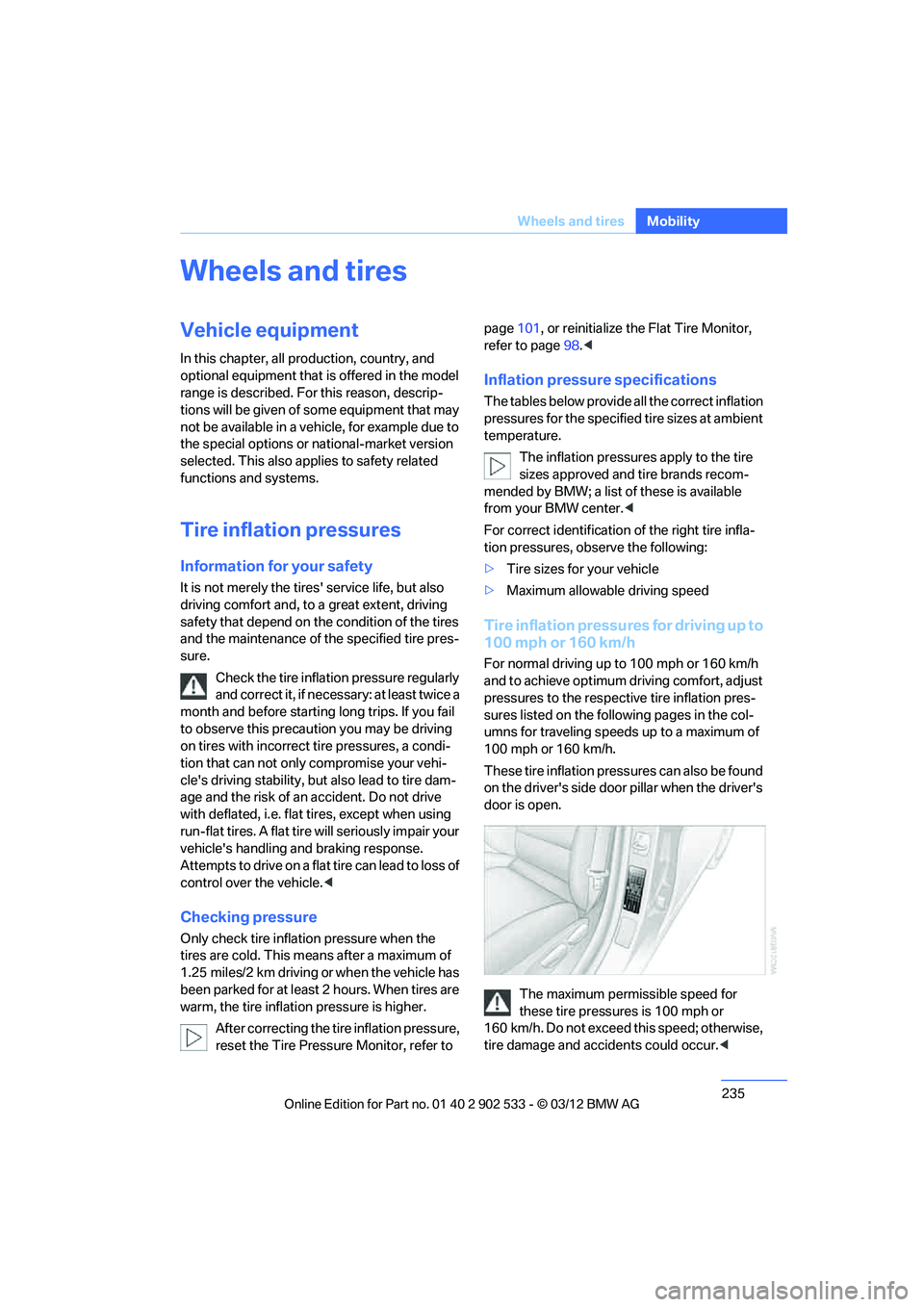
235
Wheels and tires
Mobility
Wheels and tires
Vehicle equipment
In this chapter, all production, country, and
optional equipment that is offered in the model
range is described. For this reason, descrip-
tions will be given of some equipment that may
not be available in a vehicle, for example due to
the special options or national-market version
selected. This also applies to safety related
functions and systems.
Tire inflation pressures
Information for your safety
It is not merely the tires' service life, but also
driving comfort and, to a great extent, driving
safety that depend on the condition of the tires
and the maintenance of the specified tire pres-
sure.
Check the tire inflation pressure regularly
and correct it, if necessary: at least twice a
month and before starting long trips. If you fail
to observe this precaution you may be driving
on tires with incorrect tire pressures, a condi-
tion that can not only compromise your vehi-
cle's driving stability, but also lead to tire dam-
age and the risk of an accident. Do not drive
with deflated, i.e. flat tires, except when using
run-flat tires. A flat tire will seriously impair your
vehicle's handling and braking response.
Attempts to drive on a flat tire can lead to loss of
control over the vehicle. <
Checking pressure
Only check tire inflation pressure when the
tires are cold. This means after a maximum of
1.25 miles/2 km driving or when the vehicle has
been parked for at least 2 hours. When tires are
warm, the tire inflation pressure is higher.
After correcting the tire inflation pressure,
reset the Tire Pressure Monitor, refer to page
101, or reinitialize the Flat Tire Monitor,
refer to page 98.<
Inflation pressure specifications
The tables below provide all the correct inflation
pressures for the specified tire sizes at ambient
temperature.
The inflation pressures apply to the tire
sizes approved and tire brands recom-
mended by BMW; a list of these is available
from your BMW center. <
For correct identification of the right tire infla-
tion pressures, observe the following:
> Tire sizes for your vehicle
> Maximum allowable driving speed
Tire inflation pressures for driving up to
100 mph or 160 km/h
For normal driving up to 100 mph or 160 km/h
and to achieve optimum driving comfort, adjust
pressures to the respective tire inflation pres-
sures listed on the following pages in the col-
umns for traveling speeds up to a maximum of
100mph or 160km/h.
These tire inflation pressures can also be found
on the driver's side door pillar when the driver's
door is open.
The maximum permissible speed for
these tire pressures is 100 mph or
160 km/h. Do not exceed this speed; otherwise,
tire damage and accidents could occur. <
00320051004F004C00510048000300280047004C0057004C005200510003
Page 237 of 308
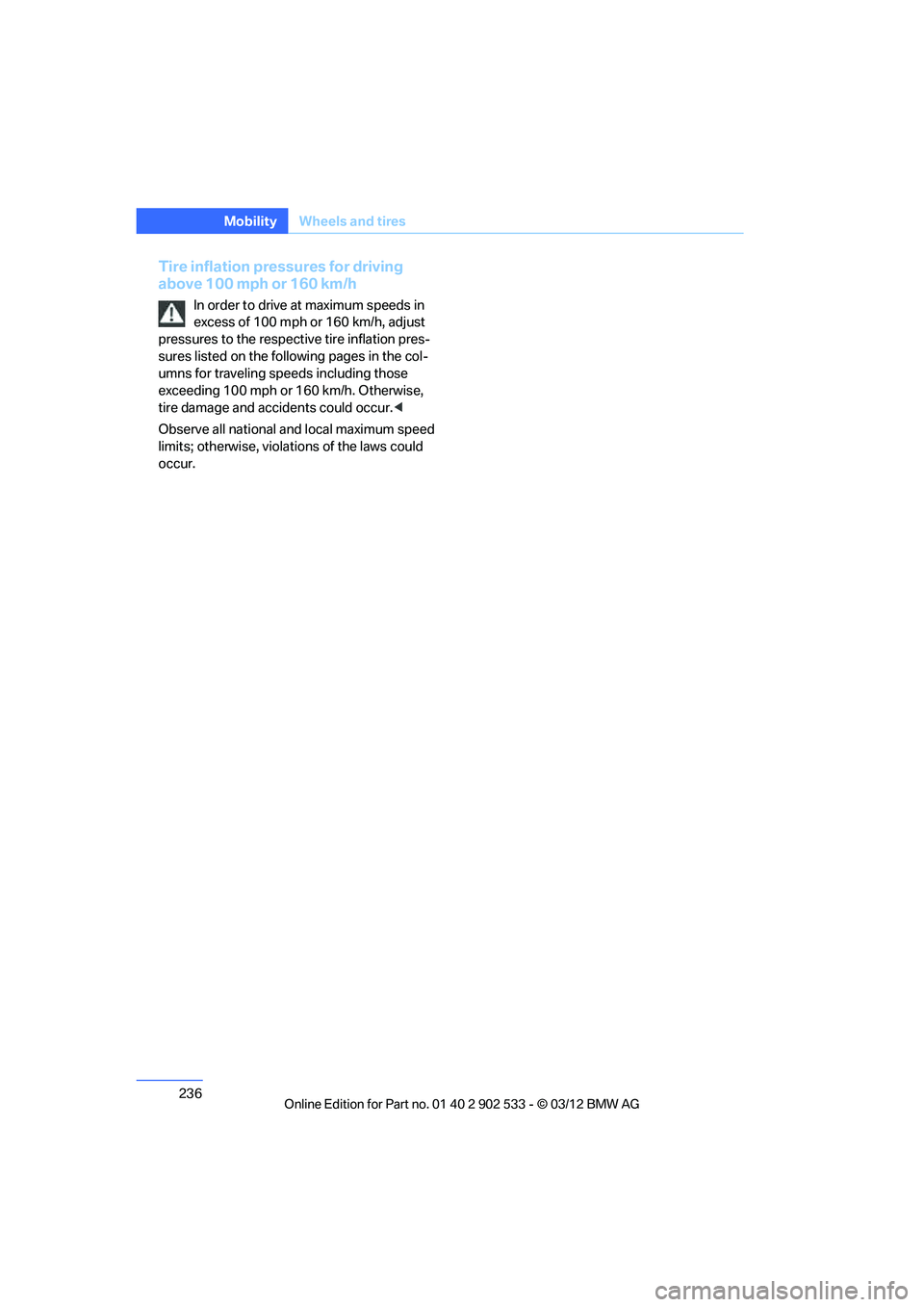
236
MobilityWheels and tires
Tire inflation pressures for driving
above 100 mph or 160 km/h
In order to drive at maximum speeds in
excess of 100mph or 160km/h, adjust
pressures to the respective tire inflation pres-
sures listed on the following pages in the col-
umns for traveling speeds including those
exceeding 100 mph or 160 km/h. Otherwise,
tire damage and accidents could occur. <
Observe all national and local maximum speed
limits; otherwise, violations of the laws could
occur.
00320051004F004C00510048000300280047004C0057004C005200510003
Page 238 of 308
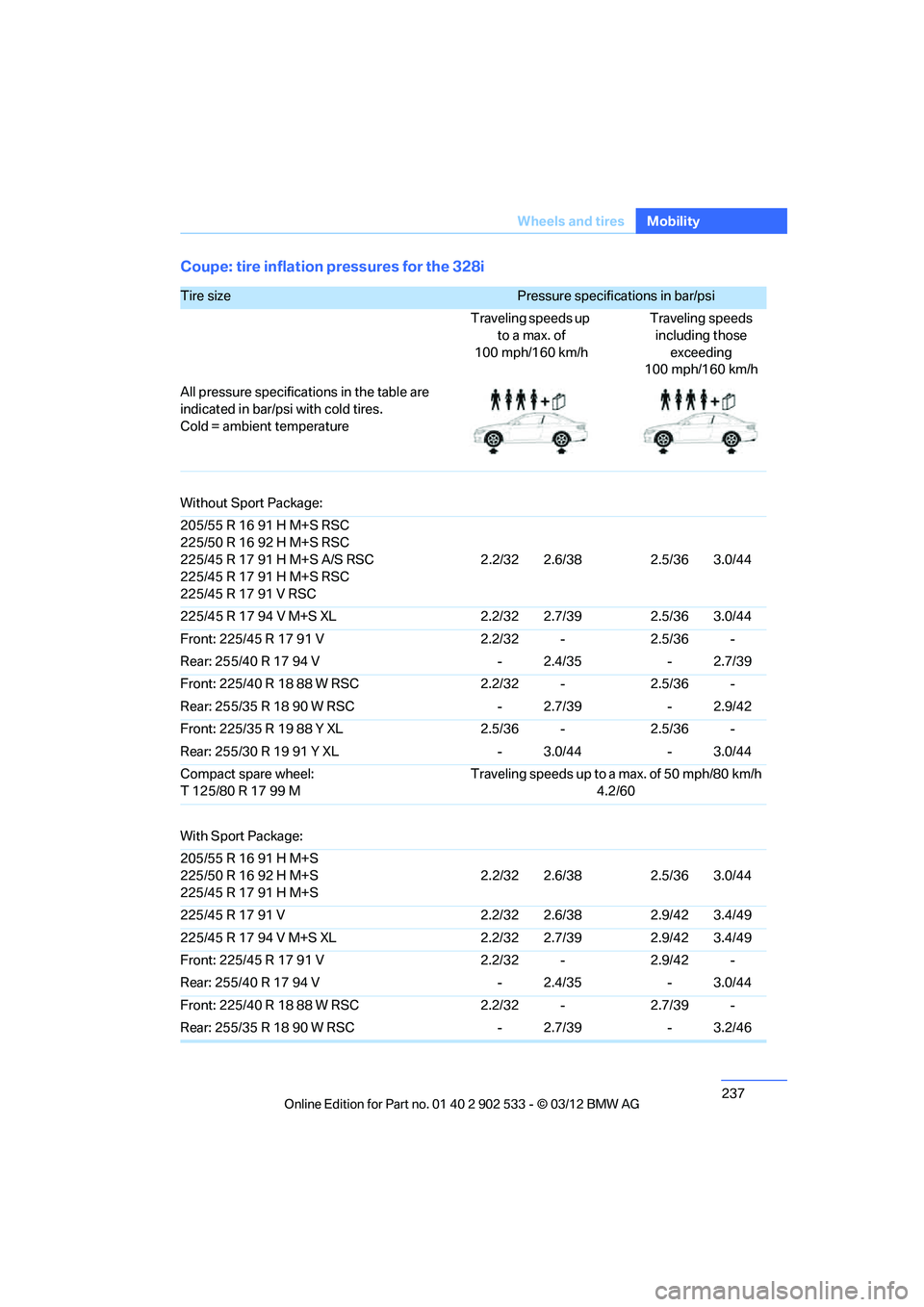
237
Wheels and tires
Mobility
Coupe: tire inflation pressures for the 328i
Tire size Pressure specifications in bar/psi
Traveling speeds up to a max. of
100 mph/160 km/h Traveling speeds
including those exceeding
100 mph/160 km/h
All pressure specifications in the table are
indicated in bar/psi with cold tires.
Cold = ambient temperature
Without Sport Package:
205/55 R 16 91 H M+S RSC
225/50 R 16 92 H M+S RSC
225/45 R 17 91 H M+S A/S RSC
225/45 R 17 91 H M+S RSC
225/45 R 17 91 V RSC 2.2/32 2.6/38 2.5/36 3.0/44
225/45 R 17 94 V M+S XL 2.2/32 2.7/39 2.5/36 3.0/44
Front: 225/45 R 17 91 V 2.2/32 - 2.5/36 -
Rear: 255/40 R 17 94 V - 2.4/35 - 2.7/39
Front: 225/40 R 18 88 W RSC 2.2/32 - 2.5/36 -
Rear: 255/35 R 18 90 W RSC - 2.7/39 - 2.9/42
Front: 225/35 R 19 88 Y XL 2.5/36 -2.5/36 -
Rear: 255/30 R 19 91 Y XL - 3.0/44- 3.0/44
Compact spare wheel:
T 125/80 R 17 99 M Traveling speeds up to a max. of 50 mph/80 km/h
4.2/60
With Sport Package:
205/55 R 16 91 H M+S
225/50 R 16 92 H M+S
225/45 R 17 91 H M+S 2.2/32 2.6/38
2.5/36 3.0/44
225/45 R 17 91 V 2.2/32 2.6/382.9/42 3.4/49
225/45 R 17 94 V M+S XL 2.2/32 2.7/392.9/42 3.4/49
Front: 225/45 R 17 91 V 2.2/32 -2.9/42 -
Rear: 255/40 R 17 94 V - 2.4/35- 3.0/44
Front: 225/40 R 18 88 W RSC 2.2/32 -2.7/39 -
Rear: 255/35 R 18 90 W RSC - 2.7/39- 3.2/46
00320051004F004C00510048000300280047004C0057004C005200510003
Page 239 of 308
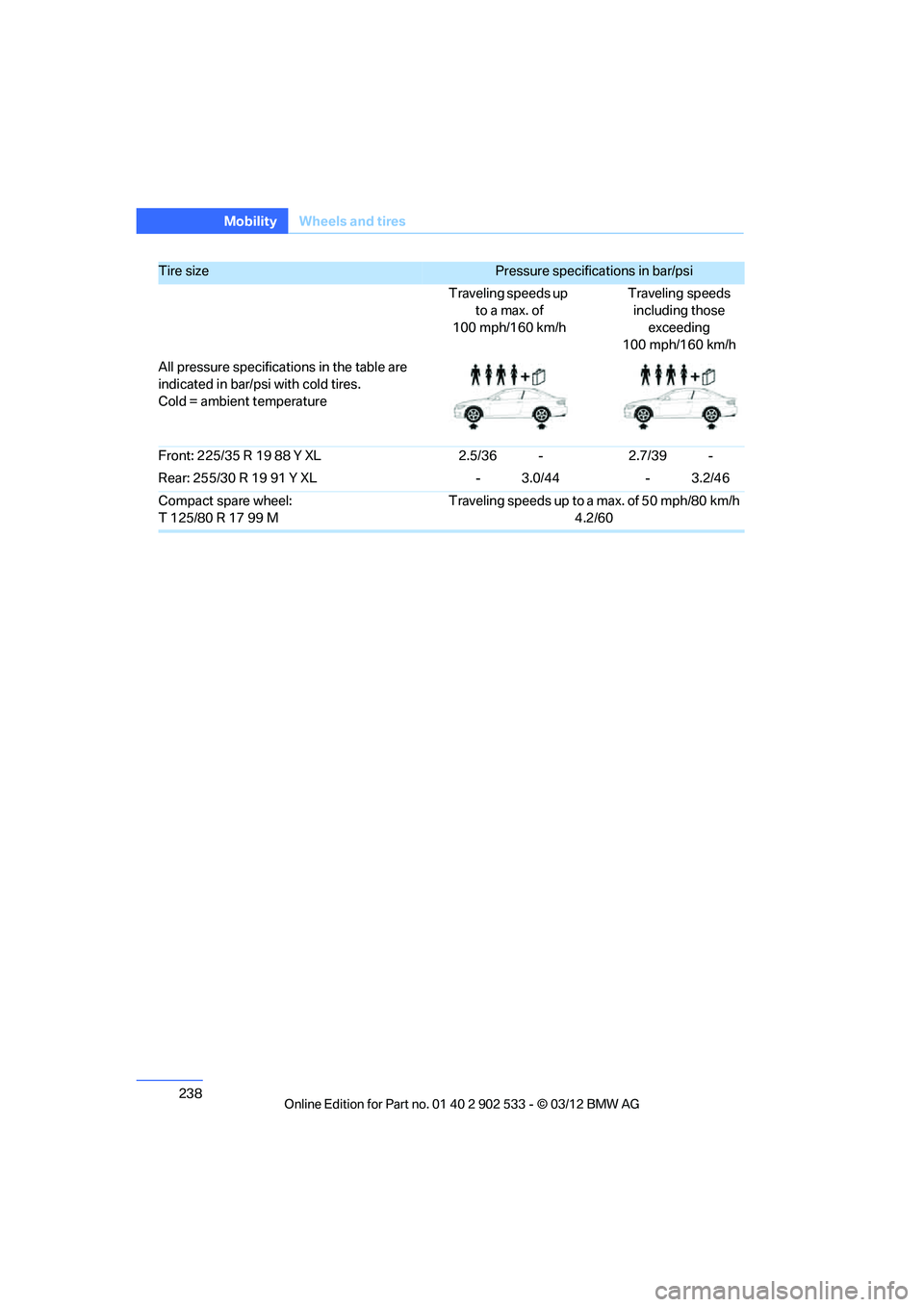
238
MobilityWheels and tires
Front: 225/35 R 19 88 Y XL 2.5/36 -2.7/39 -
Rear: 255/30 R 19 91 Y XL - 3.0/44- 3.2/46
Compact spare wheel:
T 125/80 R 17 99 M Traveling speeds up to a max. of 50 mph/80 km/h
4.2/60
Tire size Pressure specifications in bar/psi
Traveling speeds up to a max. of
100 mph/160 km/h Traveling speeds
including those exceeding
100 mph/160 km/h
All pressure specifications in the table are
indicated in bar/psi with cold tires.
Cold = ambient temperature
00320051004F004C00510048000300280047004C0057004C005200510003
Page 240 of 308
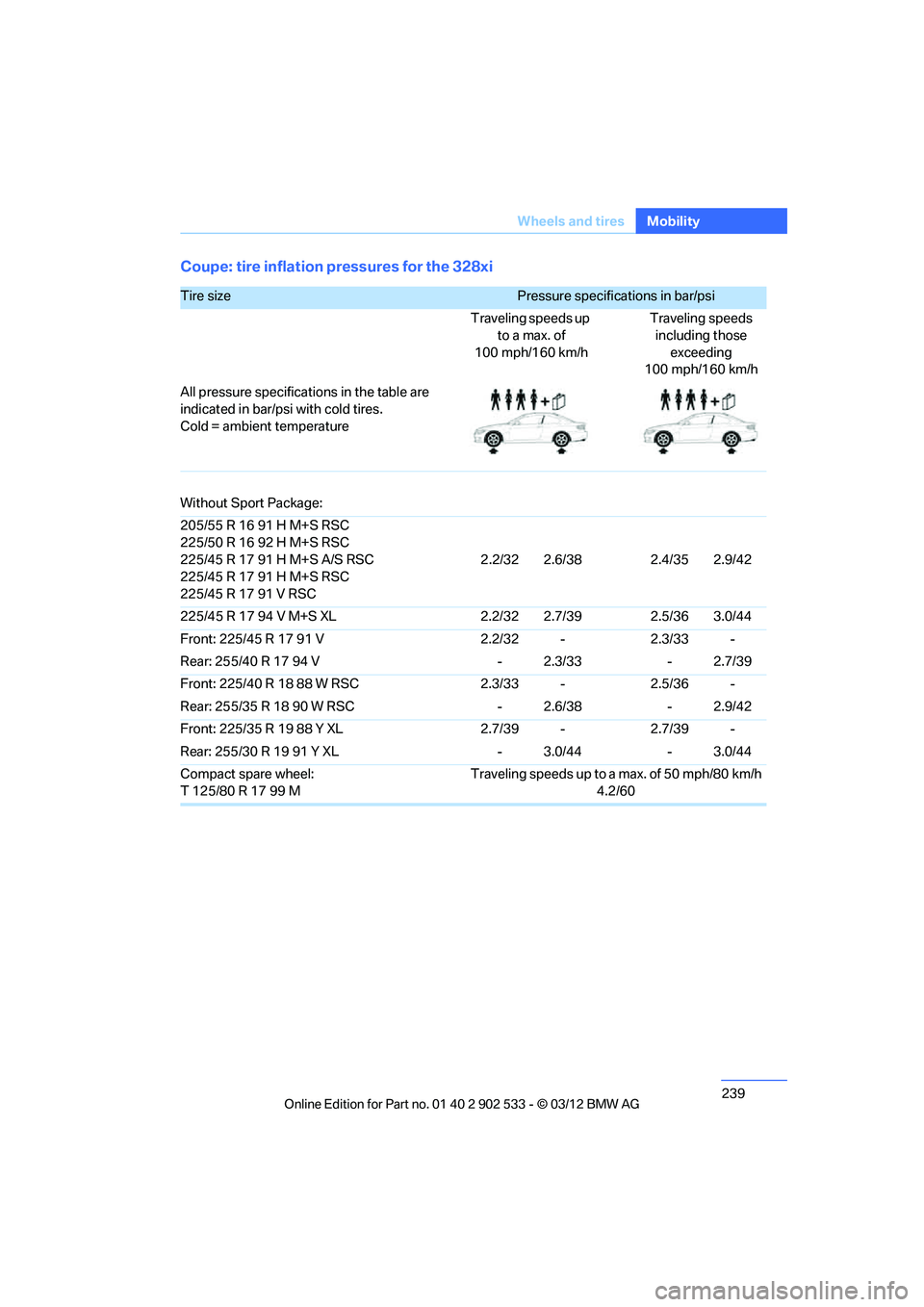
239
Wheels and tires
Mobility
Coupe: tire inflation pressures for the 328xi
Tire size Pressure specifications in bar/psi
Traveling speeds up to a max. of
100 mph/160 km/h Traveling speeds
including those exceeding
100 mph/160 km/h
All pressure specifications in the table are
indicated in bar/psi with cold tires.
Cold = ambient temperature
Without Sport Package:
205/55 R 16 91 H M+S RSC
225/50 R 16 92 H M+S RSC
225/45 R 17 91 H M+S A/S RSC
225/45 R 17 91 H M+S RSC
225/45 R 17 91 V RSC 2.2/32 2.6/38 2.4/35 2.9/42
225/45 R 17 94 V M+S XL 2.2/32 2.7/39 2.5/36 3.0/44
Front: 225/45 R 17 91 V 2.2/32 - 2.3/33 -
Rear: 255/40 R 17 94 V - 2.3/33 - 2.7/39
Front: 225/40 R 18 88 W RSC 2.3/33 - 2.5/36 -
Rear: 255/35 R 18 90 W RSC - 2.6/38 - 2.9/42
Front: 225/35 R 19 88 Y XL 2.7/39 -2.7/39 -
Rear: 255/30 R 19 91 Y XL - 3.0/44- 3.0/44
Compact spare wheel:
T 125/80 R 17 99 M Traveling speeds up to a max. of 50 mph/80 km/h
4.2/60
00320051004F004C00510048000300280047004C0057004C005200510003
Page 241 of 308

240
MobilityWheels and tires
With Sport Package:
205/55 R 16 91 H M+S
225/50 R 16 92 H M+S
225/45 R 17 91 H M+S 2.2/32 2.6/38 2.4/35 2.9/42
225/45 R 17 91 V 2.2/32 2.6/38 2.8/41 3.3/48
225/45 R 17 94 V M+S XL 2.2/32 2.7/39 2.8/41 3.3/48
Front: 225/45 R 17 91 V 2.2/32 - 2.8/41 -
Rear: 255/40 R 17 94 V - 2.3/33 - 2.9/42
Front: 225/40 R 18 88 W RSC 2.3/33 - 2.7/39 -
Rear: 255/35 R 18 90 W RSC - 2.6/38 - 3.2/46
Front: 225/35 R 19 88 Y XL 2.7/39 -2.8/41 -
Rear: 255/30 R 19 91 Y XL - 3.0/44- 3.2/46
Compact spare wheel:
T 125/80 R 17 99 M Traveling speeds up to a max. of 50 mph/80 km/h
4.2/60
Tire size Pressure specifications in bar/psi
Traveling speeds up to a max. of
100 mph/160 km/h Traveling speeds
including those exceeding
100 mph/160 km/h
All pressure specifications in the table are
indicated in bar/psi with cold tires.
Cold = ambient temperature
00320051004F004C00510048000300280047004C0057004C005200510003
Page 242 of 308
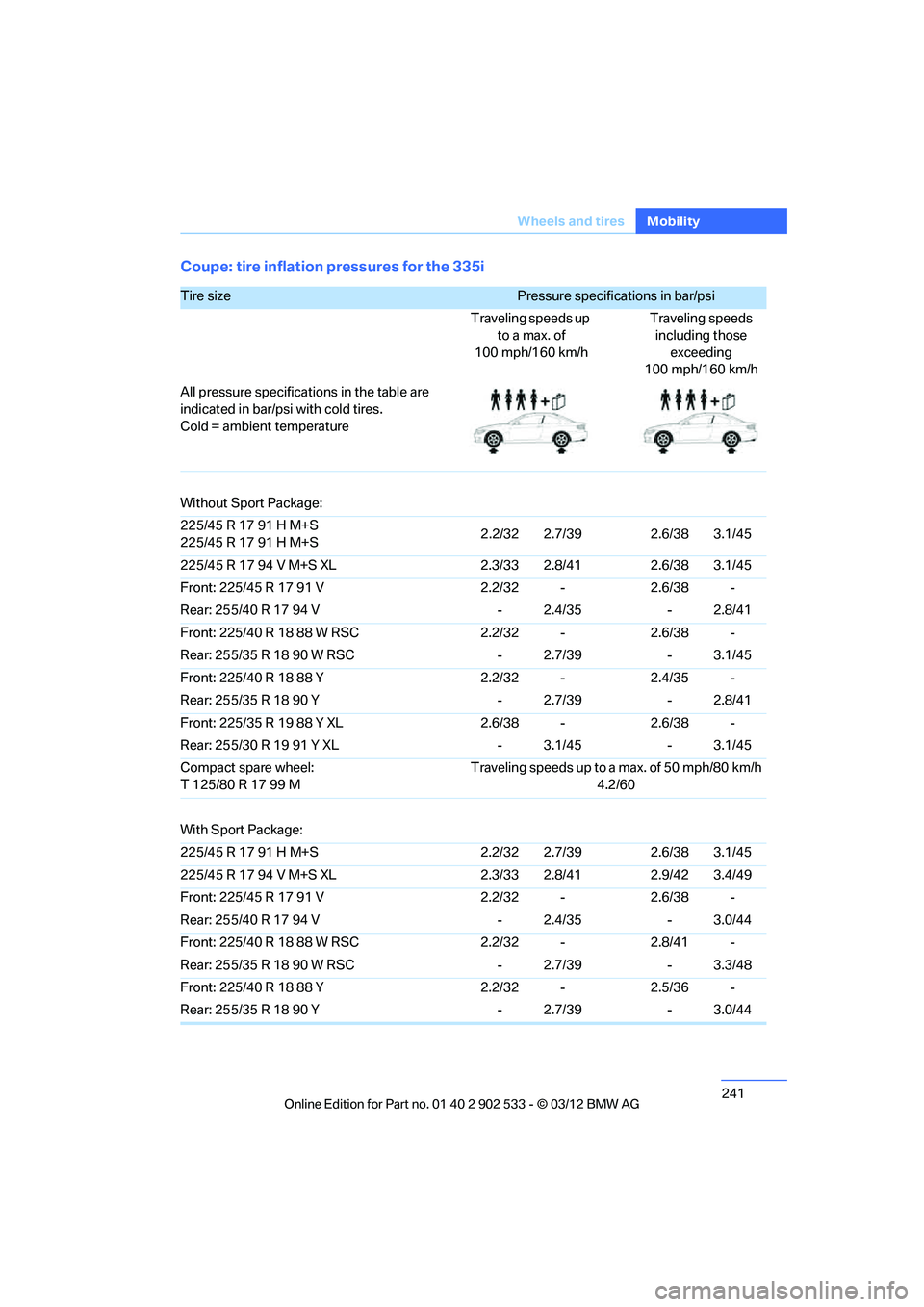
241
Wheels and tires
Mobility
Coupe: tire inflation pressures for the 335i
Tire size Pressure specifications in bar/psi
Traveling speeds up to a max. of
100 mph/160 km/h Traveling speeds
including those exceeding
100 mph/160 km/h
All pressure specifications in the table are
indicated in bar/psi with cold tires.
Cold = ambient temperature
Without Sport Package:
225/45 R 17 91 H M+S
225/45 R 17 91 H M+S 2.2/32 2.7/39 2.6/38 3.1/45
225/45 R 17 94 V M+S XL 2.3/33 2.8/41 2.6/38 3.1/45
Front: 225/45 R 17 91 V 2.2/32 - 2.6/38 -
Rear: 255/40 R 17 94 V - 2.4/35 - 2.8/41
Front: 225/40 R 18 88 W RSC 2.2/32 - 2.6/38 -
Rear: 255/35 R 18 90 W RSC - 2.7/39 - 3.1/45
Front: 225/40 R 18 88 Y 2.2/32 - 2.4/35 -
Rear: 255/35 R 18 90 Y - 2.7/39 - 2.8/41
Front: 225/35 R 19 88 Y XL 2.6/38 - 2.6/38 -
Rear: 255/30 R 19 91 Y XL - 3.1/45 - 3.1/45
Compact spare wheel:
T 125/80 R 17 99 M Traveling speeds up to a max. of 50 mph/80 km/h
4.2/60
With Sport Package:
225/45 R 17 91 H M+S 2.2/32 2.7/39 2.6/38 3.1/45
225/45 R 17 94 V M+S XL 2.3/33 2.8/41 2.9/42 3.4/49
Front: 225/45 R 17 91 V 2.2/32 - 2.6/38 -
Rear: 255/40 R 17 94 V - 2.4/35 - 3.0/44
Front: 225/40 R 18 88 W RSC 2.2/32 - 2.8/41 -
Rear: 255/35 R 18 90 W RSC - 2.7/39 - 3.3/48
Front: 225/40 R 18 88 Y 2.2/32 - 2.5/36 -
Rear: 255/35 R 18 90 Y - 2.7/39 - 3.0/44
00320051004F004C00510048000300280047004C0057004C005200510003